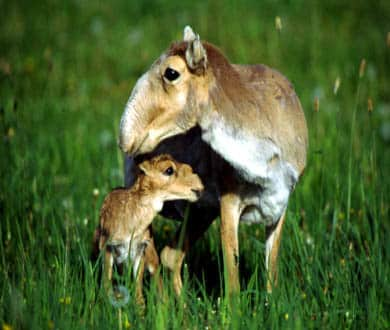Strange-looking Antelope Species Recovers from the Brink
OutdoorHub Reporters 09.23.13

On the grasslands of the Kazakh Steppe, an odd-looking creature is experiencing a second wind after escaping from the brink of extinction. According to National Geographic, the saiga antelope population now exceeds 150,000 in Kazakhstan, which contains nearly 90 percent of the world’s population.
Thousands of years ago, the saiga antelope called a vast area of Eurasia home, in addition to natural ranges throughout China and even North America. The animal’s dwindling numbers landed the species on the International Union for Conservation of Nature’s (IUCN) critically endangered species list over 10 years ago. It was at this time that local conservation organizations in countries with significant saiga populations—Kazakhstan, Mongolia, Russia, and Uzbekistan—began working together to save the species. What resulted was protection for the saiga antelope across their existing range and the creation of a reserve covering more than 1.2 million acres in Kazakhstan’s Golden Steppes. These efforts proved to be a lifeline for the antelope.
Around the turn of the millennium, experts predicted there to be only 21,000 saiga antelope left in Kazakhstan after one of the largest population collapses of any ungulate in recent memory. Eurasianet.org reports that the population had swollen to 61,000 by 2008 and has more than doubled by the latest count. Conservationists are hailing the recovery as a great success, and some are even calling for the antelope to be removed from the IUCN’s “red list” of critically endangered species. However, the same factors that caused the saiga antelope to become endangered still exist today. Over the last 15 years, poaching, disease, and habitat loss decimated over 90 percent of the antelope’s population.
Saiga antelope meant easy money for poachers, who sell their horns in the black market. The real money is made in East Asia, where the horns are used for traditional medicine and can fetch up to $2,000 per pound. Poachers would often practice a form of “persistence hunting” by running the animals to exhaustion from a car or motorcycle. Targeting males for their horns had a drastic impact on the antelope’s rutting season, leaving ratios as skewed as one breeding male per 100 females. The days when poachers had free reign over the steppes may be at an end, however, as government patrols increase and wardens are seen in force. In 2006, Uzbekistan, Turkmenistan, Mongolia, and Russia signed a Memorandum of Understanding to step up efforts to stop poaching. Non-profit organizations such as the Association for the Conservation of Biodiversity of Kazakhstan have also been on the front lines of restoring the species. For now, experts are tentatively optimistic about the saiga antelope’s future.

